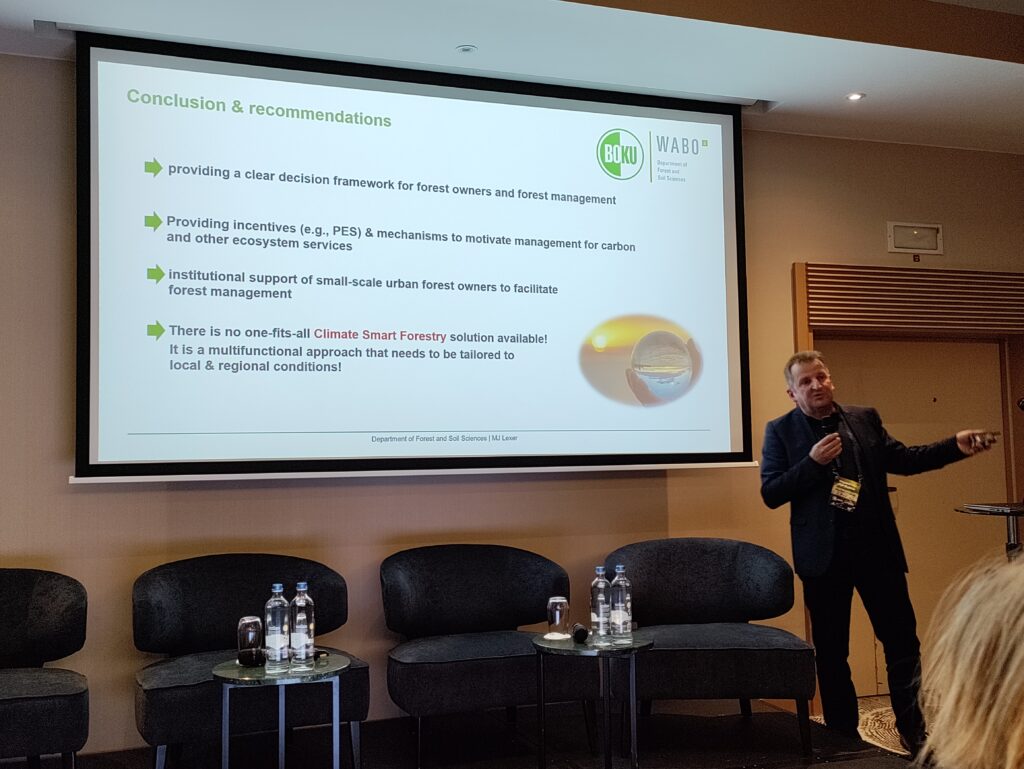Droughts, forest fires, storms, bark beetles and other disturbances can cause considerable damage to European forests. In the past decade, we have witnessed more disturbances than in the previous 30 years. As our climate changes, further increases in these disturbances are expected and this will affect biodiversity and ecosystem services, as well as the profitability of forestry.
Many policies related to forests are already in place, but they are fragmented and there is no coherent decision framework for forestry and forest owners. The topic is complex since there is no one-size-fits-all climate smart forestry solution, as measures need to be tailored to regional conditions. Therefore, a more clearly outlined decision framework is needed to tackle the issues.
Climate Smart Forestry tackles the challenges
Climate Smart Forestry builds on the sustainable utilisation and multi-functional management of forests. It aims to:
- Increase the carbon sequestration and storage capabilities of forests while enhancing biodiversity and providing multiple ecosystem services
- Enhance the resilience of forests to climate change through adaptive forest management
- Use wood resources sustainably so they can substitute for non-renewable and more carbon-intensive materials and energy.
Multi-functional Climate Smart Forestry provides synergies and decreases the trade-offs between ecosystem services. The actions needed vary in the short and long term, and are dependent on the severity of climate change. Activities, such as avoiding deforestation, the retention of old and dead trees, as well as the restoration of peatland hydrology, can benefit both forest biodiversity and climate change mitigation.
Less intensive harvesting would enhance forest biodiversity and increase carbon stocks in the short term. However, in the long term, carbon sequestration would decrease because growth decreases in aging forests and the risks of multiple disturbances, and therefore sudden carbon emissions released in to the atmosphere, increases e.g. through large scale forest fires and bark beetle infestation damage. Therefore, there is also a trade-off between biodiversity and climate change mitigation in forest management decision-making.
To achieve targets, regional differences need to be considered
A clear decision framework, that can be adapted according to regional differences, is needed for forest owners and forest management. Different types of incentives and mechanisms that motivate forest owners to manage their forests for carbon sequestration and other ecosystem services are an essential part of the required framework.
As is the institutional support of small-scale urban-dwelling forest owners to facilitate the management of their forests. Tailored forest management can be more profitable than current practices and, at the same time, it can support forest owners in achieving environmental goals.

Gamification and TREE-level information take forest management to the next level
The latest research developments in individual-tree-level forest inventory and gamification are making advances that will facilitate Climate Smart Forestry. Through supporting science and data literacy, as well as the engagement of people across the bio-society, they can accelerate participatory decision-making that takes all ecosystem services into account and improve the monitoring of forest biodiversity.
Furthermore, individual-tree-level information and gamification could be used to improve the estimation of the development and value of forests, enhance electronic wood trade, and transform supply-chain logistics – from the forest all the way to value-added end-products. Gamification can also bring greater well-being from forests and provide more meaningful human-nature experiences – both in real and virtual forest environments.
Forests are part of a bigger picture in solving global problems
It should be recognised that managed forests have an important, but limited capacity to mitigate climate change. This is because the mitigation effect of using wood for products and energy is still relatively low compared to forests and peatlands capacity to act as carbon sinks. However, when compared to forests, the potential of peatlands in climate change mitigation is not yet fully acknowledged, and peatland degradation continues.
This is why a coherent decision-making framework that implements Climate Smart Forestry, and recognizes the multiple uses of forests, needs to be adopted at the EU level. It is important that all dimensions of sustainable forestry should be considered in a balanced way. Therefore, in November 2022, two Academy of Finland research flagships, UNITE and FinnCERES, joined forces to deliver this message in the heart of the European Union in Brussels, Belgium.
The flagship professors presented the research that supports this conclusion at a variety of events with policymakers and stakeholders that are involved in the many legislative proposals currently taking place which will affect the future of Europe’s forests. Access to the latest scientific knowledge is key to effective policy making so it is vital that researchers and policy makers are active in communicating developments.
UNITE and FinnCERES together cover the whole value network, from the forest to wood-based bio-materials and products, and serve to provide scientific knowledge for enabling more substantiated and fair policy-making and decision-making in the forest bio-economy sector.
Photos: Varpu Heiskanen, UEF (1st), Jukka Hassinen, Aalto University (2nd)
